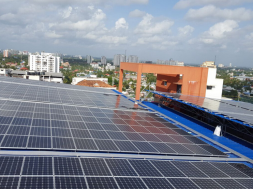
Union Budget 2024 Ratul Puri Calls for Policy Boost and AI Revolution to Achieve India’s Ambitious Power Targets – EQ
In Short : In the Union Budget 2024, Ratul Puri advocates for a significant policy boost and the integration of AI technology to help India meet its ambitious power targets. He emphasizes the need for strategic initiatives and technological advancements to drive the country’s energy sector forward, ensuring sustainable and efficient power generation to meet the growing demand.
In Detail : India has been making significant strides in the renewable energy sector, aiming to transform its energy landscape and reduce its dependence on fossil fuels. One of the key figures driving this transformation is Ratul Puri, Chairman of Hindustan Power Group. Under his leadership, the company has emerged as a frontrunner in the renewable energy revolution, with a particular focus on solar energy. Ratul Puri’s insights and strategic vision have been instrumental in shaping the company’s success and positioning it as a leader in the power generation sector.
As India prepares for the Union Budget 2024, there is a keen interest in understanding how policy measures will support the renewable energy industry’s growth and sustainability. In an exclusive conversation, Ratul Puri shares his expectations from the upcoming budget, the challenges faced by the solar energy sector, and the role of emerging technologies like artificial intelligence in revolutionizing India’s power sector.
Q: Mr Ratul Puri, as a leader in the Indian renewable energy sector, what are your expectations from Budget 2024?
A: India has set an ambitious target of installing 500 GW of non-fossil fuel-based energy capacity by 2030, with solar energy forming the majority of this addition. Achieving this objective requires policy measures that can significantly boost our industry’s growth and sustainability. First, we need substantial financial support from the government, as we must add a minimum of 50 GW of renewable energy capacity annually to reach our target. Additionally, investment in R&D is crucial to ensure that the equipment we produce, such as solar panels, can withstand extreme weather events like heatwaves.
To make our projects competitive and economically viable, the GST on solar components should be reduced to 5%. It will encourage broader adoption of solar energy across the country. Moreover, reducing import duties on solar panels and components will be essential to making solar energy more affordable and accessible. Local manufacturers should be provided incentives and subsidies, better access to working capital, and viability gap funding to reduce dependence on imports.
Q: Mr Puri, you have mentioned extreme weather events. How do they affect solar energy equipment?
A: India enjoys a sunshine period of about 10 months, which is advantageous for harnessing solar energy. However, extreme weather events such as heatwaves, coupled with increasing power demand, adversely affect solar panels. These panels are designed to work efficiently between 15 degrees and 35 degrees Celsius. As temperatures rise, the efficiency of solar electricity generation declines. Prolonged exposure to higher temperatures can reduce the efficiency of PV cells by 10%-25%. While monocrystalline panels offer an alternative, they are more expensive. Therefore, as I mentioned earlier, investing in R&D to develop weather-resistant solar technology is essential to keep it affordable for all Indians.
Q: Artificial intelligence is all the rage now. How do you see the role of artificial intelligence in India’s power sector, Mr Puri?
A: Artificial intelligence represents the future of India’s power sector and has the potential to transform the industry completely. AI can enhance the efficiency, reliability, and sustainability of power generation and distribution. AI algorithms analyze vast datasets from power grids, wind turbines, solar panels, and other sources to optimize energy production and consumption. They can predict maintenance needs, minimize downtime, and reduce costs by anticipating equipment failures before they occur. AI can also improve grid management, balancing supply and demand in real-time, which is crucial for integrating renewable energy sources.
Of course, there are challenges, such as the high energy consumption of AI systems, cybersecurity risks, and the need for skilled manpower. However, I am confident that with the government’s support, we will overcome these challenges and harness the full potential of AI in the power sector.











